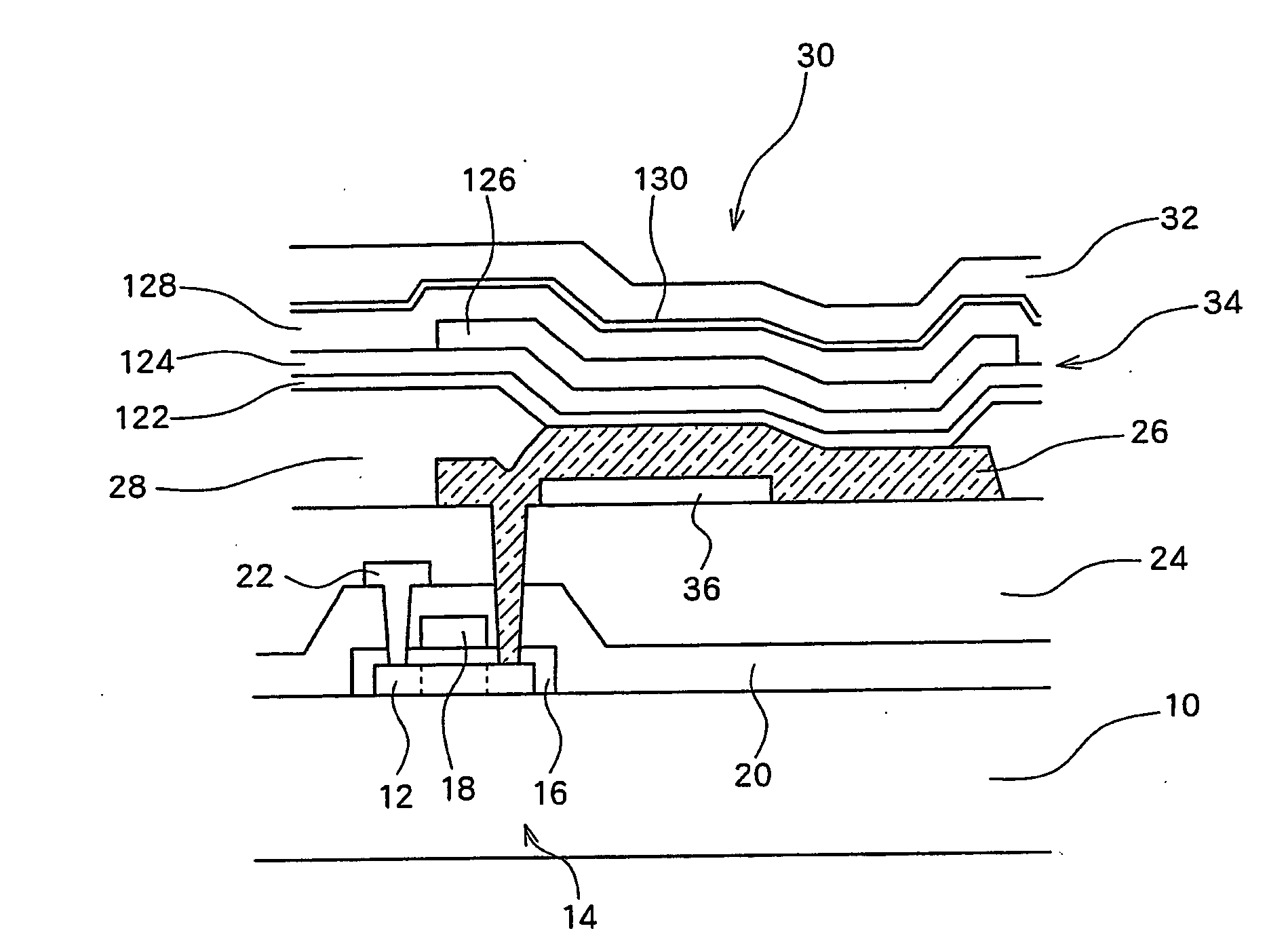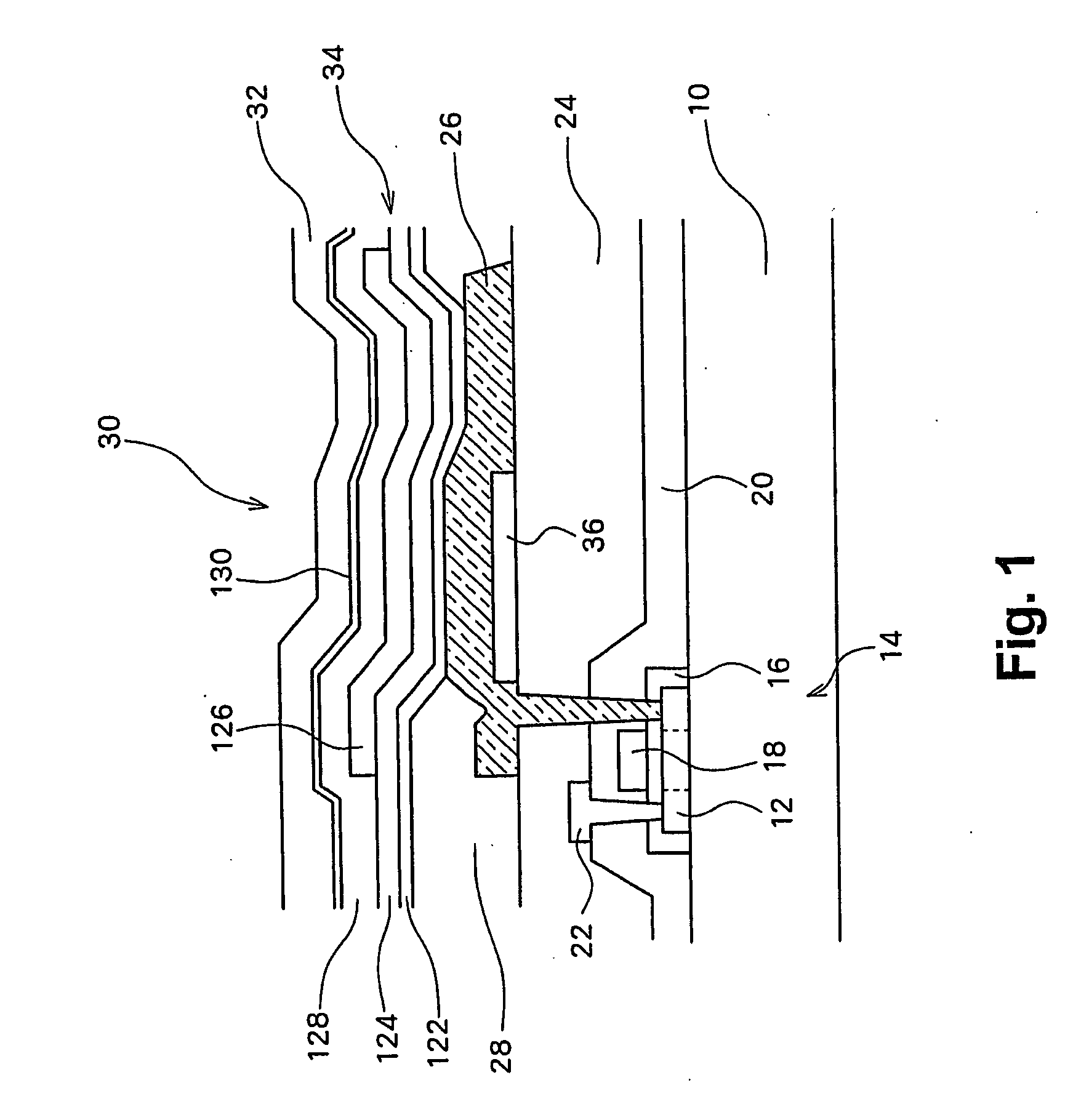Organic EL panel
- Summary
- Abstract
- Description
- Claims
- Application Information
AI Technical Summary
Benefits of technology
Problems solved by technology
Method used
Image
Examples
first embodiment
[0025]FIG. 1 is a cross-sectional view schematically showing the arrangement of a microcavity structure in a pixel of a display panel in accordance with a first embodiment of the present invention.
[0026] A semiconductor layer 12, formed at a predetermined place of a glass substrate 10, can constitute a TFT, electrodes, or wiring. According to the example shown in FIG. 1, the semiconductor layer 12 constitutes source, channel, and drain regions of a drive TFT 14. A gate insulating film 16 covers the semiconductor layer 12 of the drive TFT 14. A gate electrode 18, formed on the gate insulating film 16, is positioned above the channel region of the semiconductor layer 12.
[0027] An interlayer insulating film 20, formed on the gate electrode 18 and the gate insulating film 16, entirely covers the upper surface of the glass substrate 10. A source electrode 22, extending across the interlayer insulating film 20, contacts the source region of the drive TFT 14. A first flattening film 24 c...
second embodiment
[0043]FIG. 3 shows an essential structure of a pixel in accordance with a second embodiment of the present invention. The lower reflection film 36 of the second embodiment covers the entire surface of the light emitting region. The organic layer 34 is partly thickened in a predetermined region of the light emitting region. According to the example of the second embodiment, the hole transporting layer 124 is relatively thick in a left part of the light emitting region and relatively thin in a right part of the light emitting region.
[0044] The characteristics of the microcavity structure can be determined according to the distance (i.e., cavity length) between the upper reflection film and the lower reflection film. Accordingly, in the present embodiment, the organic layer 34 having a partly changed thickness can provide two regions in the light emitting layer which are differentiated in cavity length. Thus, the wavelength of the light enhanced by the microcavity structure can be loc...
third embodiment
[0077]FIG. 7 shows an essential structure of a pixel in accordance with a third embodiment of the present invention. The lower reflection film 36 of the third embodiment covers the entire surface of the light emitting region. The lower reflection film 36 of the third embodiment is constituted by the above-described multilayered dielectric films. The thickness of the lower reflection film 36 is locally differentiated in each pixel (i.e., in one light emitting region).
[0078] More specifically, a thick region of the lower reflection film 36 can be constituted by a larger number of dielectric film layers while a thin region of the lower reflection film 36 can be constituted by a smaller number of dielectric film layers. According to the example shown in FIG. 7, the lower reflection film 36 is thick in a left part of the light emitting region and thin in a right part of the light emitting region.
[0079] The characteristics of the microcavity structure can be determined according to the ...
PUM
 Login to View More
Login to View More Abstract
Description
Claims
Application Information
 Login to View More
Login to View More - R&D
- Intellectual Property
- Life Sciences
- Materials
- Tech Scout
- Unparalleled Data Quality
- Higher Quality Content
- 60% Fewer Hallucinations
Browse by: Latest US Patents, China's latest patents, Technical Efficacy Thesaurus, Application Domain, Technology Topic, Popular Technical Reports.
© 2025 PatSnap. All rights reserved.Legal|Privacy policy|Modern Slavery Act Transparency Statement|Sitemap|About US| Contact US: help@patsnap.com



